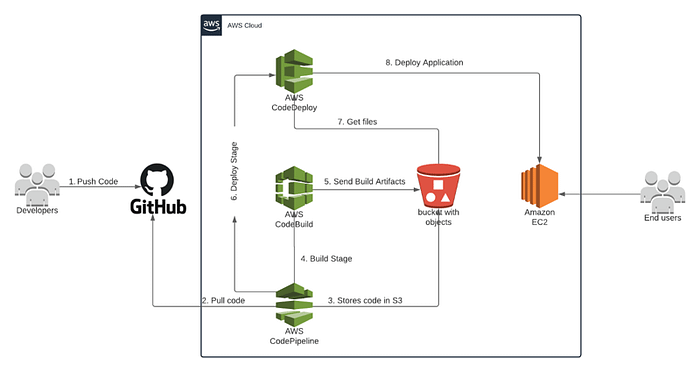In today’s fast-paced software development landscape, continuous integration and continuous delivery (CI/CD) are critical for delivering high-quality software quickly and efficiently. AWS CodePipeline, along with GitHub and AWS CodeBuild, provides a robust solution for setting up a seamless CI/CD pipeline. This guide will walk you through the process of integrating AWS CodePipeline with GitHub and CodeBuild, ensuring your code is built, tested, and deployed smoothly.

1. Prerequisites
Before we dive into the integration process, ensure you have the following prerequisites in place:
- An AWS account
- A GitHub account
- Basic knowledge of AWS services and CI/CD concepts
2. Setting Up Your GitHub Repository
- Create a Repository: Start by creating a repository on GitHub if you don’t have one already. This repository will house your source code and configurations.
- Push Your Code: Push your application code to this repository. Make sure to include a build specification file (
buildspec.yml) in the root directory of your repository, which defines the build commands and phases.
3. Configuring AWS CodeBuild
- Navigate to AWS CodeBuild: Sign in to the AWS Management Console and open the AWS CodeBuild console.
- Create a Build Project:
- Click on “Create build project.”
- Project Name: Enter a name for your build project.
- Source Provider: Select “GitHub” and connect your GitHub account.
- Repository: Choose the repository you created earlier.
- Build Environment: Choose the environment image and runtime that suits your project.
- Buildspec: If your repository contains a
buildspec.ymlfile, AWS CodeBuild will use it. Alternatively, you can define the build commands directly in the console.
3. Service Role: Create a service role or choose an existing one. This role allows AWS CodeBuild to access other AWS services.
4. Create the Build Project: Review your settings and click “Create build project.”
4. Setting Up AWS CodePipeline
- Navigate to AWS CodePipeline: In the AWS Management Console, go to the AWS CodePipeline console.
- Create a New Pipeline:
- Click on “Create pipeline.”
- Pipeline Name: Provide a name for your pipeline.
- Service Role: Choose an existing service role or create a new one.
3. Add Source Stage:
- Source Provider: Select “GitHub.”
- Repository: Connect your GitHub account and select the repository.
- Branch: Choose the branch you want to monitor for changes.
4. Add Build Stage:
- Build Provider: Select “AWS CodeBuild.”
- Build Project: Choose the build project you created earlier.
5. Add Deploy Stage (Optional):
- Deploy Provider: Choose a deployment service like AWS Elastic Beanstalk, Amazon ECS, or AWS Lambda, depending on your application’s needs.
6. Review and Create: Review your pipeline configuration and click “Create pipeline.”
5. Testing Your Pipeline
- Push Changes: Make a change to your GitHub repository and push it to the branch you’re monitoring.
- Monitor Pipeline Execution: Go to the AWS CodePipeline console and watch as your pipeline picks up the changes, builds the code, and deploys it.
6. Troubleshooting and Optimization
- Logs: Use AWS CodeBuild and AWS CodePipeline logs to troubleshoot any issues that arise during the build or deployment process.
- Notifications: Set up notifications using Amazon SNS to stay informed about pipeline events.
For a visual walkthrough of the concepts covered in this article, check out my YouTube playlist:-
Conclusion
Integrating AWS CodePipeline with GitHub and CodeBuild can significantly streamline your CI/CD processes, allowing for faster and more reliable software delivery. By following this guide, you’ve set up a robust pipeline that automates the build, test, and deployment stages of your development workflow.
Feel free to modify and extend this pipeline based on your project’s requirements and complexity. Happy coding!
Connect with Me:
- YouTube ► S3 CloudHub Channel
- Facebook ► S3 CloudHub Page
- Medium ► S3 CloudHub Blog
- Demo Reference ► GitHub Repository
- Blog ► S3 CloudHub Blogspot
- Dev ► S3 CloudHub on Dev.to

No comments:
Post a Comment